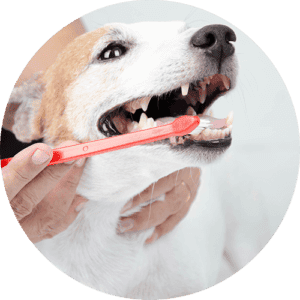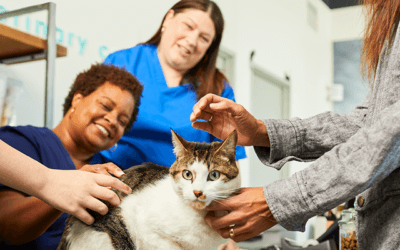It’s common knowledge in the veterinary industry that periodontal disease is the most prevalent concern with dogs and cats today. In addition, the AVMA found that 20%-27% of canine patients have fractured teeth and up to 60% of feline patients have resorptive lesions.
Dental disease prevention and treatment is often a low priority for pet owners as well as clinic staff. When we see a sick patient and also note that they have dental disease, we often “put the teeth aside” and deal with the presenting complaint.
Does this sound familiar? “We’ll get this UTI under control and deal with his teeth later.” But when? And at what cost to the patient’s well-being?
It’s time for change. Focusing on dental compliance in your practice can have a two-fold positive outcome: healthier pets and a healthier practice. So let’s dig into 4 ways you can help your clients say yes to the vet, specifically yes to dentistry.
4 ways to increase dental compliance
Newsflash: Clients don’t necessarily know what you are seeing/doing/feeling during a physical exam unless you tell them.
Explain and show what you are seeing in your patient’s mouth to their owner. Explain what plaque vs. tartar is, how bacteria builds up, and what effect it can have on other systems in the body. Verbalized exams encourage communication and heighten the value of services to clients.
 Be specific in your recommendations and why you are making them. Saying “Boscoe’s teeth are in dire needs of a scale and polish. I’m concerned about his gingivitis and we really need to see what’s going on below the gumline to assess the extent of his dental disease” goes far beyond “you should consider dentistry.” It also opens up the door for questions from the owner, which increases engagement and compliance.
Be specific in your recommendations and why you are making them. Saying “Boscoe’s teeth are in dire needs of a scale and polish. I’m concerned about his gingivitis and we really need to see what’s going on below the gumline to assess the extent of his dental disease” goes far beyond “you should consider dentistry.” It also opens up the door for questions from the owner, which increases engagement and compliance.
Discuss dental home care with all clients who bring in their pets for an annual or bi-annual exam. To help patients be more comfortable with brushing their teeth at home, it’s best to start at a young age.
Pro Tip: New owners are often incredibly eager to do the very best for the new addition to the family, so the more you encourage them, the better for your patient.
Once dentistry is recommended, you need to go over the “dreaded” estimate.
First off, let’s call it a treatment plan from now on. It’s more accurate and focuses less on the overall cost and more on the medical services needed. Go through your treatment plan line by line, explaining what each item means, and why it’s needed.
[bctt tweet=”Your entire team needs to be comfortable explaining treatment plans to owners.”]
For many clients, this may be the first veterinary treatment plan they have seen and they may have countless questions:
- What is an anesthetic induction?
- Why does my pet need IV fluids?
- What’s a Pre-An 560?
- Why do you have to do x-rays?
- Etc etc etc
Although dental and anesthetic procedures are day-to-day occurrences for those in the veterinary industry, they can be stressful and mysterious to owners. It’s your job to help them understand and feel comfortable with the process.
Pro Tip: Always allow additional wiggle room on your treatment plan for medication to go home post-op. No one wants to be surprised by an additional $150.00 at the end of the day for antibiotics and pain meds that weren’t initially accounted for.
 You have a rock star team: utilize them!
You have a rock star team: utilize them!
Technicians and assistants can do dental assessments, teach clients how to brush their pet’s teeth, recommend dental products, and explain treatment plans. Giving your staff responsibilities like these empowers them, strengthens the bond between your clients and staff, and gives your DVMs time to record treatment plans, invoices, and medical records.
Pro Tip: Make sure your practice is aligned on the products you recommend. Maybe you have a go-to type of oral rinse, water additive, or dental treat.
When you recommend dentistry, owners should be encouraged to forward-book procedures. This can be recommended by the DVM, then followed-up by the technician and client care representative. This ensures better compliance and saves valuable time by not having to track down that client at a later date. If they do not forward-book, the client care rep can make a follow-up reminder call for the future.
A little can go a long way in helping your clients understand the value of dentistry. On top of the classic free bag of dental food or a discount on their dentistry if booked within a certain timeframe, you can also include a dental report card, before and after photos, copies of their dental x-rays, and a dental chart. All these items add value to the service you provide and allow for transparency into what procedures and treatments their pet received and why.
Pro Tip: Ensure your clients have an informative discharge appointment with one of your technicians to explain all post-op care. Discharge appointments should always be done in an exam room, away from the hustle and bustle of the reception area.
You can’t just say “let’s focus on dentistry!” at a staff meeting, cross your fingers, and hope for better dental compliance.
Make sure all staff members are comfortable discussing dentistry with clients. Encourage your staff to learn from each other: a role-play exercise can quickly show which staff members are more comfortable discussing dentistry than others. Allow the more confident staff to help others learn and grow.
Next, set goals for your practice and then track your progress. You should be able to answer the following questions:
- Are we doing more dentistries?
- What is our dentistry revenue compared to the average practice?
- Are particular doctors or staff members excelling at identifying dentistry opportunities?
- Are others trailing behind?
An excellent way to track your progress is with the VetSuccess monthly Practice Overview Report and Compliance Tracker.
The Practice Overview Report will show your practice’s dentistry revenue every month, with dental x-rays broken out separately, and how that compares to the national average or benchmark. The report also has a Chart of Accounts Revenue Statement, which will show your practice’s dentistry revenue growth over time, as well as your other revenue streams.
The Compliance Tracker enables practices to identify what percentage each veterinarian is ensuring dentistry compliance, as well as other areas of preventive care. This tool is virtually impossible to replicate in any PIMS and allows you to see which providers are excelling at educating clients about the importance of dentistry and which are potentially struggling.
Pro Tip: You can get a demo to see exactly how VetSuccess works here.
Dental compliance = healthier pets and practices

As we progressively grow our practices, we are continuously looking for areas to improve our standard of care, the services we provide, as well as our bottom line.
Dentistry is an area of care that is so necessary, and yet so neglected in our profession. It needs greater attention and importance placed on it, so that we can continue to provide the best care to our patients and allow our businesses to flourish.
So, what ways will you focus on dental compliance moving forward?
Originally from Nova Scotia, Katie moved to Toronto to complete her undergraduate degree in art and art history. During that time, she took a part-time job as a kennel attendant and never looked back. Over the next decade, Katie worked tirelessly in almost every role a veterinary clinic has to offer. From client communication to inventory management, from cat wrangling to hamster anesthesia, Katie’s varied experience in the veterinary world is certainly an asset in her current role as Customer Success Manager for VetSuccess.



